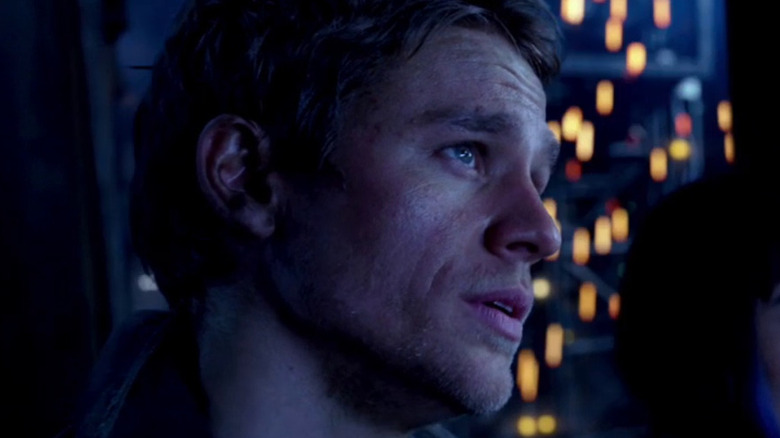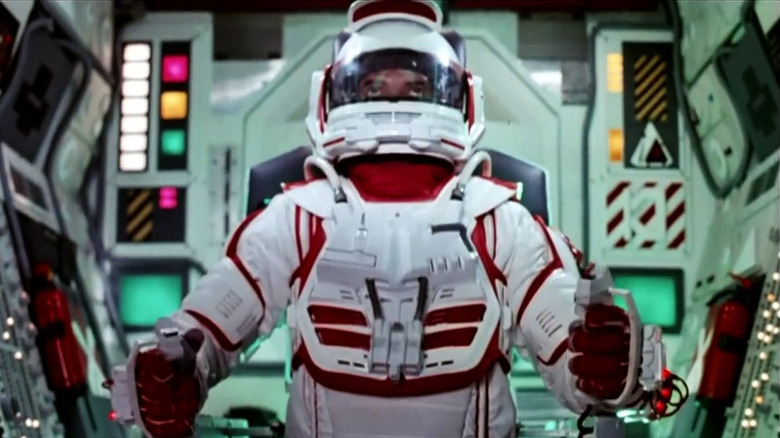The Movie Like Pacific Rim That Giant Robot Fans Need To See
For many viewers, "Pacific Rim" — 2013's giant-robots-fighting-giant-interdimensional-monsters popcorn slugfest from visionary director Guillermo del Toro — is a polarizing film. The film tells the tale of humanity on the brink, proceeding in medias res amidst a sporadic battle against monstrous, dimension-hopping creatures called Kaiju — a nod to the Japanese monster movie genre of the same name — that are invading the planet through a portal called the Breach, which lies at the bottom of the Pacific Ocean. The citizens of Earth have banded together to fight the Kaiju with giant, human-piloted robotic machines called Jaegers, after the German word for "hunter." Jaeger co-pilot Raleigh Beckett (Charlie Hunnam) brings the audience up to speed with an exposition dump and a montage, right before heading out on patrol with his brother Yancy (Diego Klattenhoff) in their two-man rig, Gipsy Danger, only to encounter a Category-3 Kaiju codenamed "Knifehead," with disastrous results.
Audiences and critics alike either loved or hated "Pacific Rim," without many people who saw the multi-genre homage falling in between those two extremes. Detractors found fault in the film's style-over-content approach, whereas others praised it for what it accomplished as a visual masterpiece in the form of a summer popcorn blockbuster. "Pacific Rim" has a 72% critics score on review aggregator Rotten Tomatoes — which is good enough to remain on the right side of "fresh." It also managed to gross $411 million worldwide against a budget of $190 million (via Box Office Mojo), which was seemingly enough for Universal Pictures to order up a piping-hot 2018 "Pacific Rim" sequel and Netflix to order a "Pacific Rim" anime series.
Viewers looking to get some more giant-robot action can check out a lower-tech film that was released more than 20 years prior, one in which world powers duke it out in an arena, vying for land and resources in a dystopian future.
Robot Jox preceded the CGI era and is deliciously cheesy
Viewers eager for a live-action mech movie that takes advantage of modern technology might have to hold out for the upcoming Netflix "Gundam" film. But those with an appreciation for outdated special effects and a solid central conceit would do well to watch 1990's "Robot Jox" from director Stuart Gordon, who made the 1985 cult horror fave "Re-Animator." The title is a bit cringey, it was panned by critics, and it's not boasting A-list stars in its cast; so why should you watch "Robot Jox"? Because it was essentially the first live-action mech story, a monumental undertaking when armed only with old-school practical effects, prior to the proliferation of modern CGI technology. Think of "Robot Jox" as the cliche senior citizen of the genre, telling young'uns like "Pacific Rim" and the upcoming "Gundam" movie it had to walk 10 miles in the snow every morning to get to school. It's the admirable forebear of the genre that did the best it could with what it had to work with through ingenuity, hard work, and good, old-fashioned gumption. Well, that and models, miniatures, and stop-motion effects.
"Robot Jox" is a dystopian tale of the post-apocalyptic future of Earth, decades after a nuclear holocaust. The planet is a wasteland; with resources scarce, the remaining powers have done away with traditional warfare and instead settle disputes via gladiatorial combat, with each nation sending its champion — called jocks, because clearly "Robot Jockeys" would have sounded even more silly — in a giant robotic suit to vie for land and resources. As Achilles (Gary Graham), a retiring jock for the Market — the future representation of the United States — finishes up his 10-fight conscription against Alexander (Paul Koslo), champion of the Confederation — the future version of Russia, playing on Cold War themes — the powers that be prepare for the next era of jock combat with "tubies," genetically engineered fighters trained from birth. There's, perhaps, a bit too much universe building, but the themes and concepts play well with Gordon's direction and modern audiences may be kinder to this sci-fi cult classic.

